Page 1 of 320
Introduction 4
Instrument Cluster 10
Warning and control lights 10
Gauges 15
Entertainment Systems 19
AM/FM stereo cassette with CD 19
AM/FM stereo with CD 37
Rear seat controls 51
Rear seat entertainment system 57
Climate Controls 69
Manual heating and air conditioning 69
Electronic automatic temperature control 72
Lights 81
Headlamps 81
Turn signal control 84
Bulb replacement 86
Driver Controls 92
Windshield wiper/washer control 92
Power windows 99
Speed control 103
Message center 114
Locks and Security 128
Keys 128
Locks 128
Anti-theft system 129
Table of Contents
1
Page 8 of 320
These are some of the symbols you may see on your vehicle.
Vehicle Symbol Glossary
Safety Alert
See Owner’s Guide
Fasten Safety BeltAir Bag-Front
Air Bag-SideChild Seat
Child Seat Installation
WarningChild Seat Tether
Anchorage
Brake SystemAnti-Lock Brake System
Brake Fluid -
Non-Petroleum BasedTraction Control
AdvanceTracMaster Lighting Switch
Hazard Warning FlasherFog Lamps-Front
Fuse CompartmentFuel Pump Reset
Windshield Wash/WipeWindshield
Defrost/Demist
Rear Window
Defrost/DemistPower Windows
Front/Rear
Introduction
8
Page 9 of 320
Vehicle Symbol Glossary
Power Window Lockout
Child Safety Door
Lock/Unlock
Interior Luggage
Compartment Release
Symbol
Panic Alarm
Engine OilEngine Coolant
Engine Coolant
TemperatureDo Not Open When Hot
BatteryAvoid Smoking, Flames,
or Sparks
Battery AcidExplosive Gas
Fan WarningPower Steering Fluid
Maintain Correct Fluid
LevelMAX
MIN
Emission System
Engine Air FilterPassenger Compartment
Air Filter
JackCheck fuel cap
Low tire warning
Introduction
9
Page 70 of 320
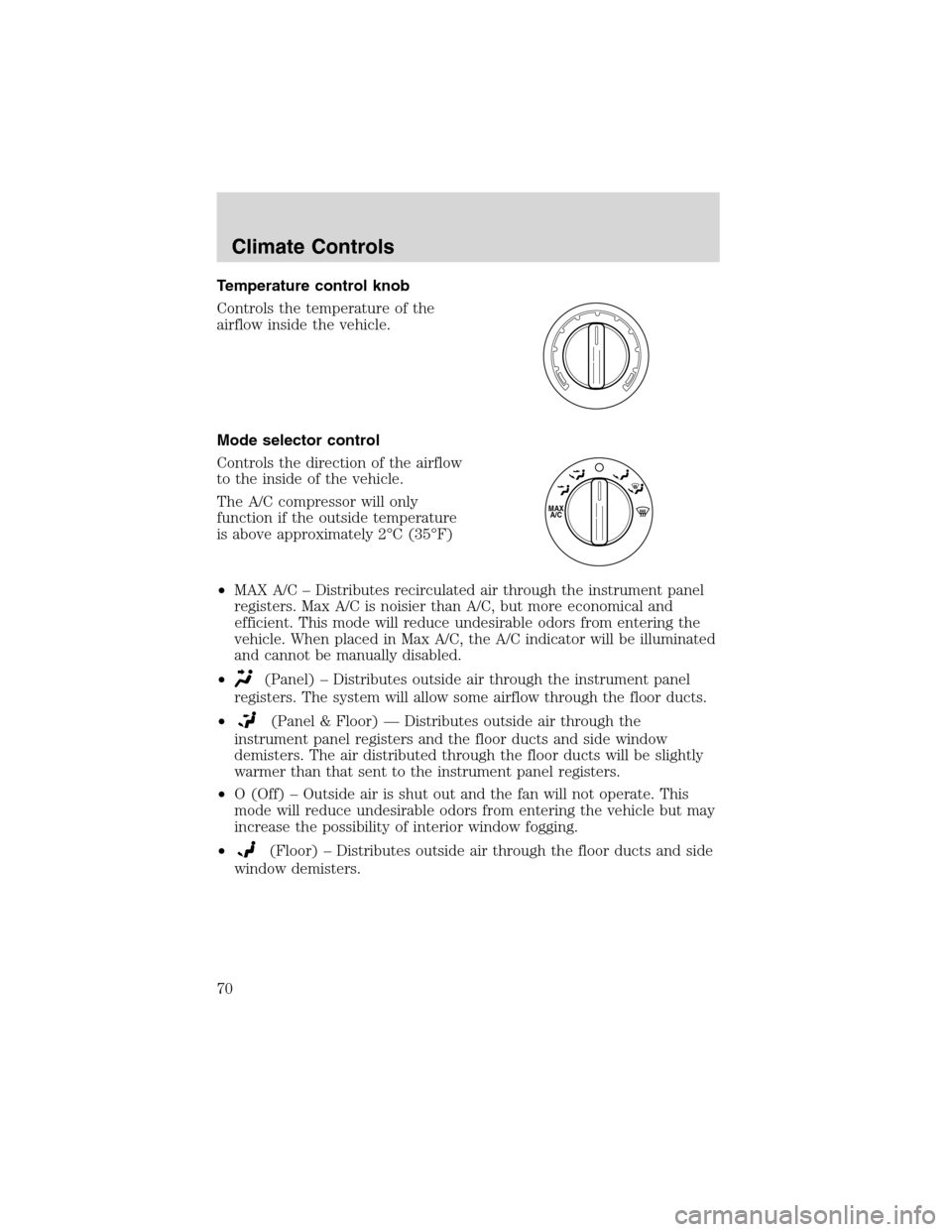
Temperature control knob
Controls the temperature of the
airflow inside the vehicle.
Mode selector control
Controls the direction of the airflow
to the inside of the vehicle.
The A/C compressor will only
function if the outside temperature
is above approximately 2°C (35°F)
•MAX A/C–Distributes recirculated air through the instrument panel
registers. Max A/C is noisier than A/C, but more economical and
efficient. This mode will reduce undesirable odors from entering the
vehicle. When placed in Max A/C, the A/C indicator will be illuminated
and cannot be manually disabled.
•
(Panel)–Distributes outside air through the instrument panel
registers. The system will allow some airflow through the floor ducts.
•
(Panel & Floor)—Distributes outside air through the
instrument panel registers and the floor ducts and side window
demisters. The air distributed through the floor ducts will be slightly
warmer than that sent to the instrument panel registers.
•O (Off)–Outside air is shut out and the fan will not operate. This
mode will reduce undesirable odors from entering the vehicle but may
increase the possibility of interior window fogging.
•
(Floor)–Distributes outside air through the floor ducts and side
window demisters.
MAX
A/C
Climate Controls
70
Page 71 of 320
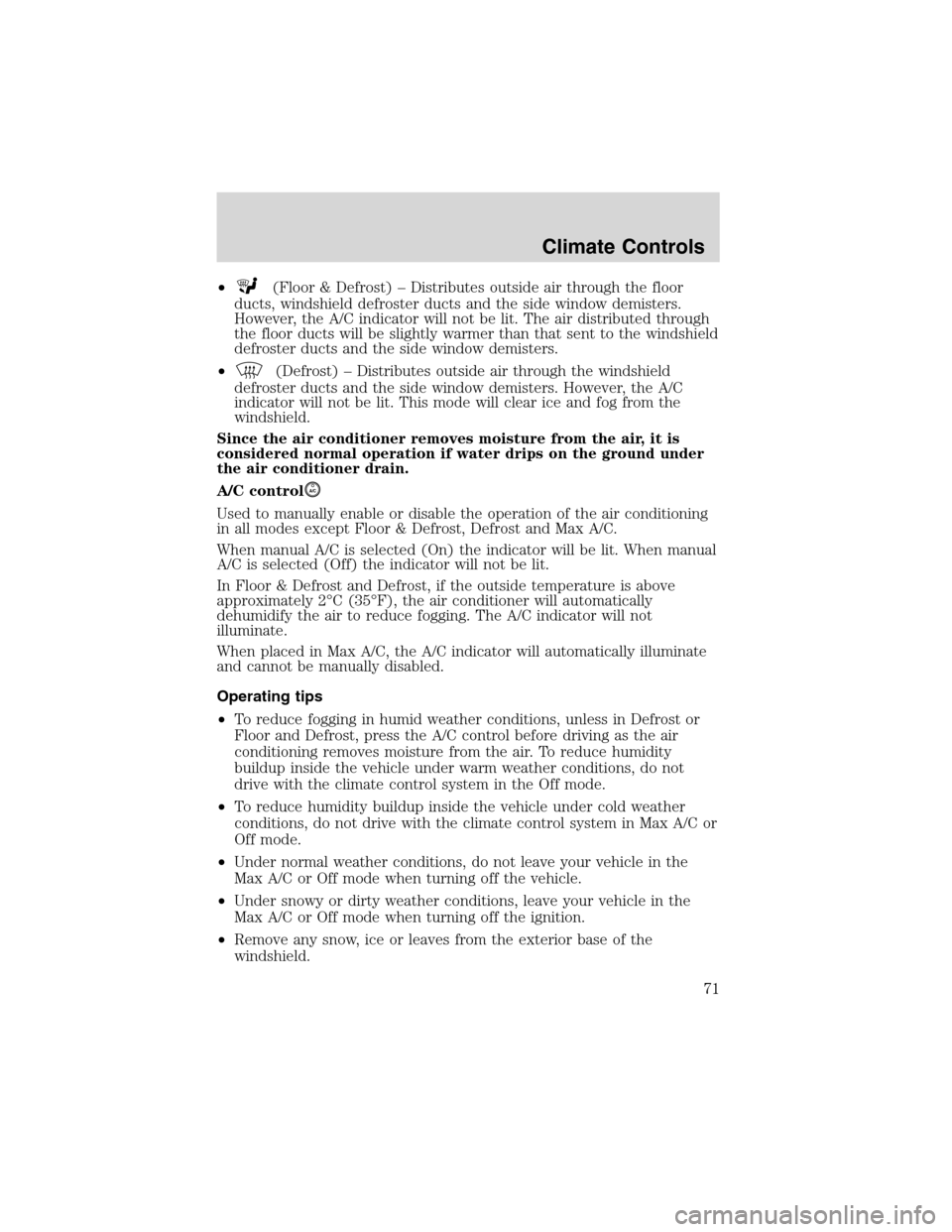
•(Floor & Defrost)–Distributes outside air through the floor
ducts, windshield defroster ducts and the side window demisters.
However, the A/C indicator will not be lit. The air distributed through
the floor ducts will be slightly warmer than that sent to the windshield
defroster ducts and the side window demisters.
•
(Defrost)–Distributes outside air through the windshield
defroster ducts and the side window demisters. However, the A/C
indicator will not be lit. This mode will clear ice and fog from the
windshield.
Since the air conditioner removes moisture from the air, it is
considered normal operation if water drips on the ground under
the air conditioner drain.
A/C control
A/C
Used to manually enable or disable the operation of the air conditioning
in all modes except Floor & Defrost, Defrost and Max A/C.
When manual A/C is selected (On) the indicator will be lit. When manual
A/C is selected (Off) the indicator will not be lit.
In Floor & Defrost and Defrost, if the outside temperature is above
approximately 2°C (35°F), the air conditioner will automatically
dehumidify the air to reduce fogging. The A/C indicator will not
illuminate.
When placed in Max A/C, the A/C indicator will automatically illuminate
and cannot be manually disabled.
Operating tips
•To reduce fogging in humid weather conditions, unless in Defrost or
Floor and Defrost, press the A/C control before driving as the air
conditioning removes moisture from the air. To reduce humidity
buildup inside the vehicle under warm weather conditions, do not
drive with the climate control system in the Off mode.
•To reduce humidity buildup inside the vehicle under cold weather
conditions, do not drive with the climate control system in Max A/C or
Off mode.
•Under normal weather conditions, do not leave your vehicle in the
Max A/C or Off mode when turning off the vehicle.
•Under snowy or dirty weather conditions, leave your vehicle in the
Max A/C or Off mode when turning off the ignition.
•Remove any snow, ice or leaves from the exterior base of the
windshield.
Climate Controls
71
Page 72 of 320
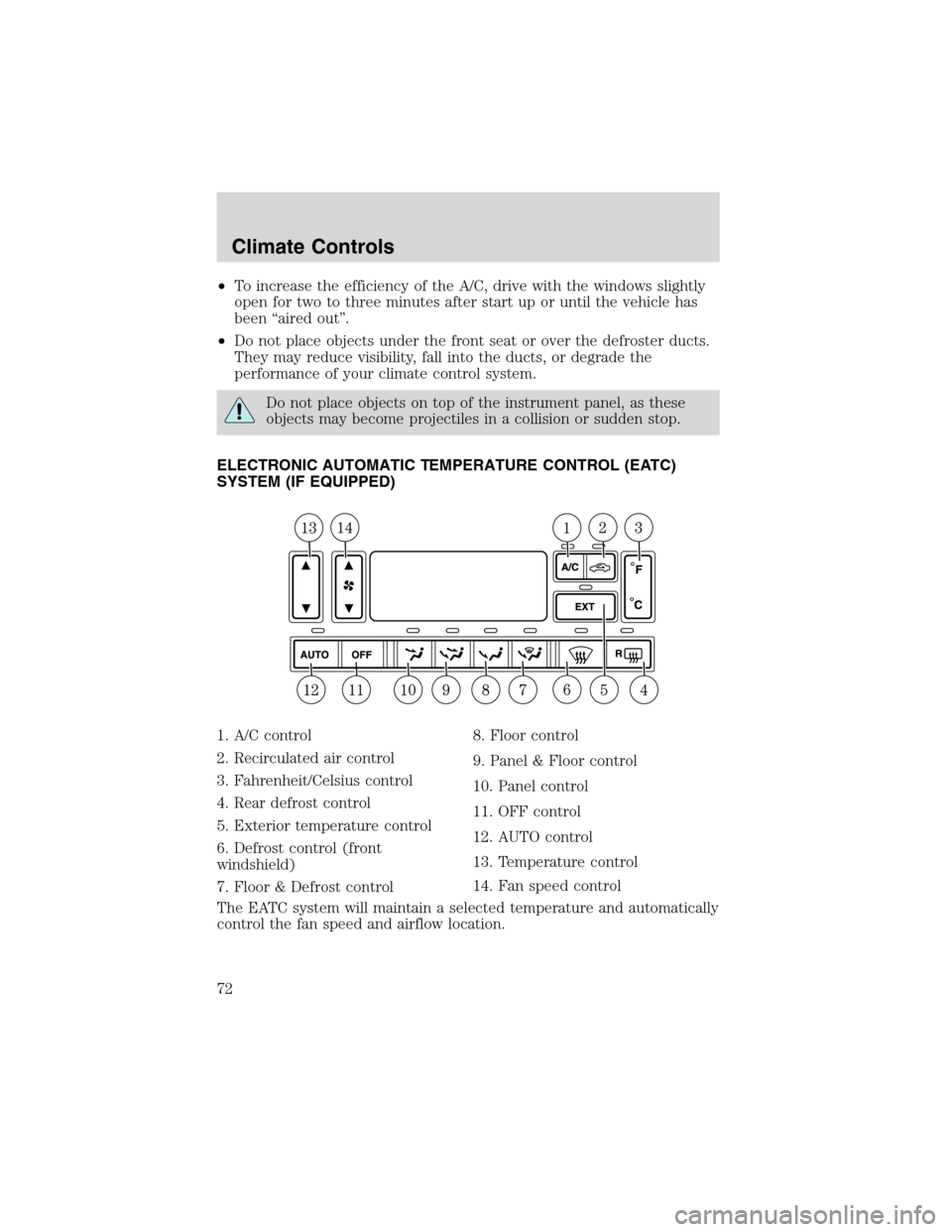
•To increase the efficiency of the A/C, drive with the windows slightly
open for two to three minutes after start up or until the vehicle has
been“aired out”.
•Do not place objects under the front seat or over the defroster ducts.
They may reduce visibility, fall into the ducts, or degrade the
performance of your climate control system.
Do not place objects on top of the instrument panel, as these
objects may become projectiles in a collision or sudden stop.
ELECTRONIC AUTOMATIC TEMPERATURE CONTROL (EATC)
SYSTEM (IF EQUIPPED)
1. A/C control
2. Recirculated air control
3. Fahrenheit/Celsius control
4. Rear defrost control
5. Exterior temperature control
6. Defrost control (front
windshield)
7. Floor & Defrost control8. Floor control
9. Panel & Floor control
10. Panel control
11. OFF control
12. AUTO control
13. Temperature control
14. Fan speed control
The EATC system will maintain a selected temperature and automatically
control the fan speed and airflow location.
Climate Controls
72
Page 73 of 320
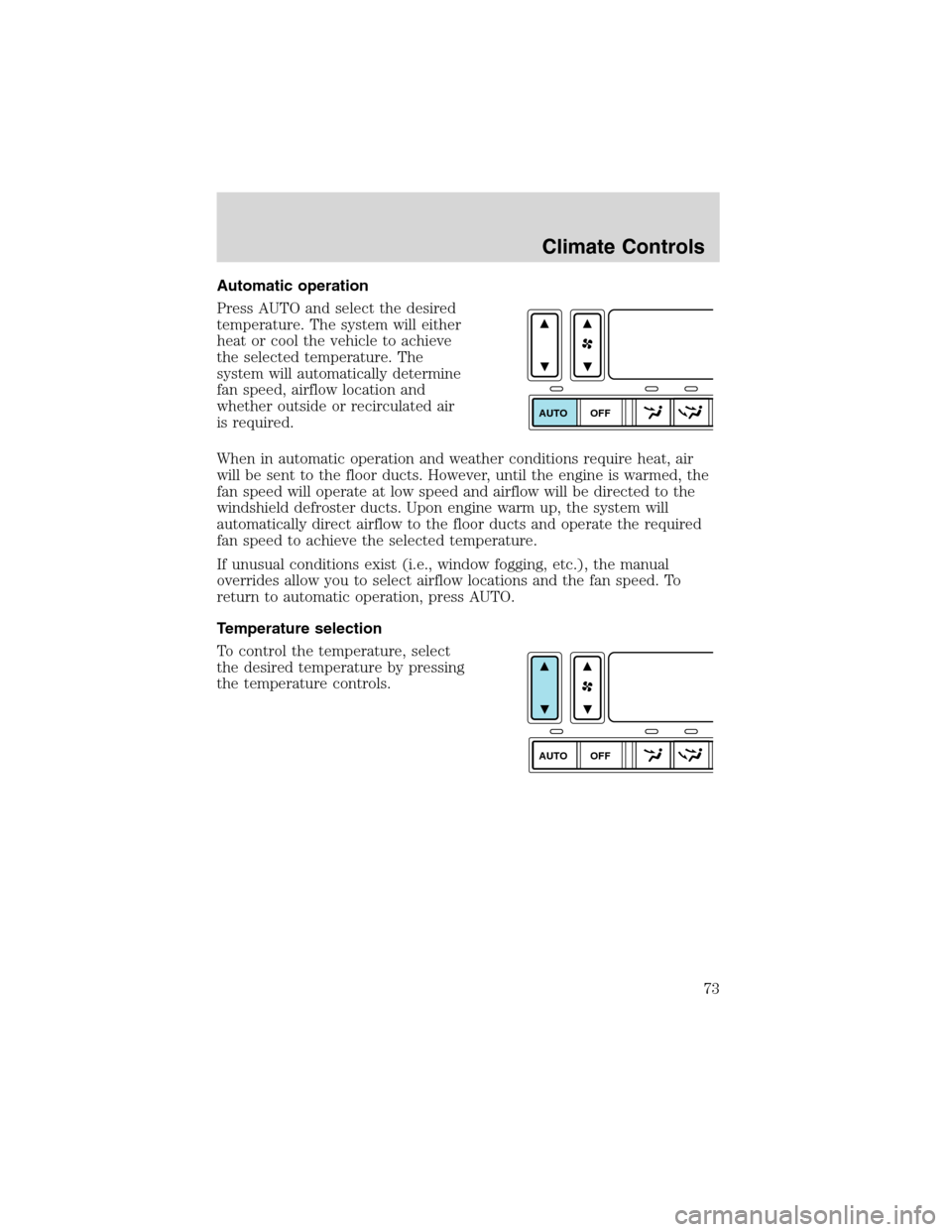
Automatic operation
Press AUTO and select the desired
temperature. The system will either
heat or cool the vehicle to achieve
the selected temperature. The
system will automatically determine
fan speed, airflow location and
whether outside or recirculated air
is required.
When in automatic operation and weather conditions require heat, air
will be sent to the floor ducts. However, until the engine is warmed, the
fan speed will operate at low speed and airflow will be directed to the
windshield defroster ducts. Upon engine warm up, the system will
automatically direct airflow to the floor ducts and operate the required
fan speed to achieve the selected temperature.
If unusual conditions exist (i.e., window fogging, etc.), the manual
overrides allow you to select airflow locations and the fan speed. To
return to automatic operation, press AUTO.
Temperature selection
To control the temperature, select
the desired temperature by pressing
the temperature controls.
AUTO
OFF
AUTO
OFF
Climate Controls
73
Page 74 of 320
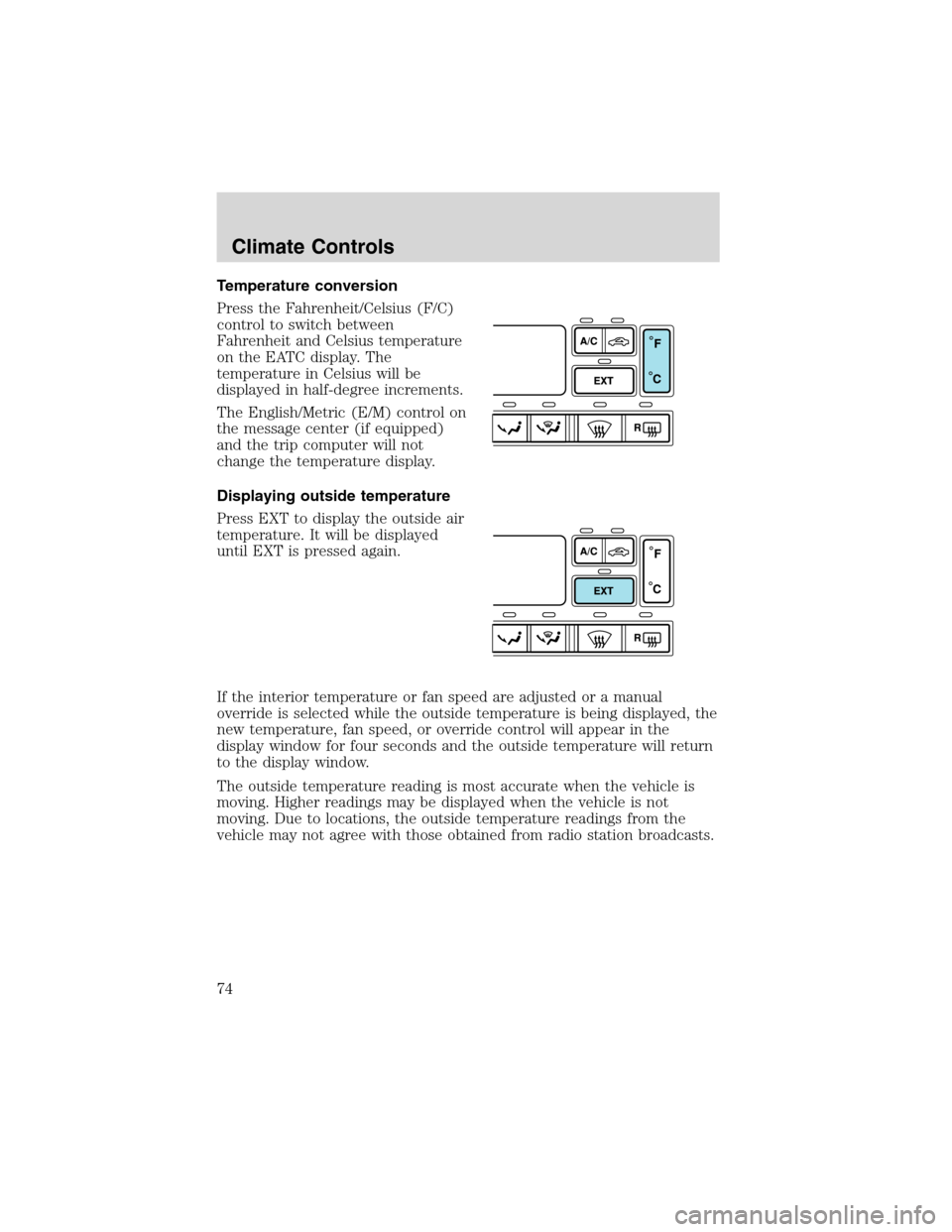
Temperature conversion
Press the Fahrenheit/Celsius (F/C)
control to switch between
Fahrenheit and Celsius temperature
on the EATC display. The
temperature in Celsius will be
displayed in half-degree increments.
The English/Metric (E/M) control on
the message center (if equipped)
and the trip computer will not
change the temperature display.
Displaying outside temperature
Press EXT to display the outside air
temperature. It will be displayed
until EXT is pressed again.
If the interior temperature or fan speed are adjusted or a manual
override is selected while the outside temperature is being displayed, the
new temperature, fan speed, or override control will appear in the
display window for four seconds and the outside temperature will return
to the display window.
The outside temperature reading is most accurate when the vehicle is
moving. Higher readings may be displayed when the vehicle is not
moving. Due to locations, the outside temperature readings from the
vehicle may not agree with those obtained from radio station broadcasts.
Climate Controls
74